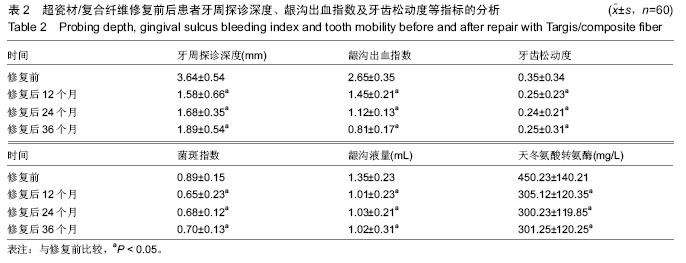| [1] 汪宏晖,程辉.超瓷材/复合纤维(TARGIS/VECTRIS)在儿童及青少年恒牙牙体缺损修复中的临床应用[J].口腔颌面修复学杂志,2002,3(2):82-84.[2] 汪宏晖,程辉,章少萍,等.超瓷材/复合纤维应用于儿童及青少年恒牙牙体缺损修复的3年临床观察[J].口腔颌面修复学杂志,2003,4(4):255-257,246.[3] 陈强.上中切牙纤维桩全瓷冠修复体冠向微渗漏的实验研究[D].中山大学,2008.[4] 刘鸿雁.超瓷树脂嵌体修复与复合树脂充填治疗磨牙大面积缺损的临床观察[J].齐齐哈尔医学院学报, 2014, 35(9):1337-1338.[5] 管婷婷,陈霞云,陈强,等.树脂直接充填与超瓷嵌体修复牙体缺损的微渗漏比较[J].中华口腔医学研究杂志(电子版), 2014,8(3):18-21.[6] 何钢清,邓敏,廖明华,等.MACRO-LOCK石英纤维桩的修复效果及安全性评价[J].中国组织工程研究与临床康复, 2011,15(25):4627-4630.[7] Ausiello P,Apicella A,Davidson CL.Effect of adhesive layer properties on stess distribution in composite restorations-a3D finite element analysis.Dent Mater. 2002;1 8(4):295-303.[8] Chai J,McCivney CP,Munoz CA,et al.A multicenterlongitudinal clinical trial of a new system for restorations.J Prosthet Dent.1997;77(1):1-11.[9] 袁冬.氧化锆桩、树脂核材料对热铸压全瓷冠材料颜色的影响[D].首都医科大学,2007.[10] 刘湘宁,周磊,熊坤,等.两种分体桩高嵌体修复无髓磨牙牙体缺损的评价[J].实用口腔医学杂志, 2011,27(4): 534-538.[11] 杨丽娟.树脂充填与聚合瓷嵌体修复牙体缺损边缘微渗漏的比较[D].河北医科大学,2009.[12] Gordan VV,RileyIII J,Worley DC,et al.Restorative material and other tooth-specific variables associated with the decision to repair or replace defective restorations: Findings from the Dental PBRN.J dent. 2012;40(5):397-405.[13] Wolf M,Lossd?Rfer S,Abuduwali N,et al.Potential role of high mobility group box protein 1 and intermittent PTH (1-34) in periodontal tissue repair following orthodontic tooth movement in rats.Clin Oral Invest. 2013;17(3):989-997.[14] 胥红,陈礼权,胡秋斌,等.超瓷材纤维嵌体在后牙牙体缺损修复中的应用[J].广东牙病防治,2011,19(9):479-481.[15] 张静,孙凤,魏克立,等.铸瓷超瓷(高)嵌体两年临床评估[J].现代口腔医学杂志,2002,16(1):65-66.[16] Zhang XH,Wang XZ.The evaluation of the carbon fiber post system on restoration of teeth defect in children. Chin Med J (Engl).2006;119(10):809-813.[17] 李长城,樊久铭,张晓冬,等.超瓷根帽结合磁性附着体在覆盖义齿中的临床应用[J].临床口腔医学杂志, 2014, 30(10): 617-618.[18] 朱明珍,姜涛.二氧化锆烤瓷牙修复牙体缺损146例体会[J].山东医药,2011,51(31):6.[19] 侯康林,刘洪臣,李亚男,等.63例老年人牙体牙列缺损烤瓷修复的疗效观察[J].解放军医学杂志, 2008,33(10):1259-1260.[20] Tian K,Peng M,Ren X,et al.Regeneration of tooth-like hydroxyapatite depended on amelogenin functional section monolayer: A new approach for tooth repair. Med Hypotheses.2012;79(2):143-146.[21] Lossdorfer S,Yildiz F,Gotz W,et al.Anabolic effect of intermittent PTH(1-34) on the local microenvironment during the late phase of periodontal repair in a rat model of tooth root resorption.Clin Oral invest. 2010; 14(1):89-98.[22] 臧传玉,马培忠,孟永慧,等.烤瓷冠修复前牙牙体缺损41例疗效观察[J].山东医药,2000,40(23):51.[23] 戴印和,戴超.纤维桩铸瓷冠在前牙重度缺损治疗中的应用[J].中国医学创新,2011,8(9):164-165.[24] 王毅.铸造金属桩核在后牙牙体大面积缺损修复中应用的临床疗效观察[D].暨南大学,2005.[25] imenez-Pellegrin C,Arana-Chavez VE.Root resorption repair in mandibular first premolars after rotation. A transmission electron microscopy analysis combined with immunolabeling of osteopontin.Am J Orthod Dentofacial Orthop.2007;132(2):230-236.[26] Szczepanska J,Poplawski T,Synowiec E,et al. 2-Hydroxylethyl methacrylate (HEMA), a tooth restoration component, exerts its genotoxic effects in human gingival fibroblasts trough methacrylic acid, an immediate product of its degradation.Mol Biol Rep. 2012;39(2):1561-1574.[27] 罗宣生.前牙牙体缺损KERR隐形瓷修复[J].中外健康文摘,2010,7(18):114-115.[28] 汪大林,戴玮霞,唐卫忠,等.复合树脂修补瓷缺损的超微结构研究[J].第二军医大学学报,2000,21(12):1169-1171.[29] 李纾,汪说之,樊明文,等.人牙龈和牙周韧带成纤维细胞的体外培养及生物学特性研究——细胞形态、生长曲线及碱性磷酸酶活性测定[J].口腔医学纵横, 2001,17(2):95-97.[30] Daoudi MF,Saunders WP.In vitro evaluation of furcal perforation repair using mineral trioxide aggregate or resin modified glass lonomer cement with and without the use of the operating microscope.J Endod. 2002; 28(7):512-515.[31] 张永宽,林珠,金作林,等.矿化液对体外培养的人牙囊细胞碱性磷酸酶活性的影响[J].牙体牙髓牙周病学杂志, 2006, 16(3):133-136.[32] 郑毅,邓嘉胤.纳米复合树脂修复龈下楔状缺损对患牙牙周组织的影响[J].山东医药, 2014,(34):57-59. [33] Tanomaru Filho M,Leonardo MR,da Silva LA,et al.Effect of irrigating solution and calcium hydroxide root canal dressing on the repair of apical and periapical tissues of teeth with periapical lesion.J Endod.2002;28(4):295-299.[34] Qehreli SB,Arhun N,Celik C,et al.Amalgam Repair: Quantitative Evaluation of Amalgam-resin and Resin-tooth Interfaces with Different Surface Treatments. Oper Dent.2010;35(3):337-344.[35] 沈一吟,陆群,魏本娟,等.不同充填材料修复对楔状缺损患牙牙周组织健康的影响[J].上海交通大学学报(医学版), 2010,30(11):1389-1392.[36] 王伟伟.三种金属材料烤瓷冠对龈沟液中碱性磷酸酶和天冬氨酸转氨酶水平的影响[D].青岛大学,2011. |
.jpg)



.jpg)